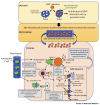The State of the Art of Pediatric Multiple Sclerosis
- PMID: 37175954
- PMCID: PMC10179691
- DOI: 10.3390/ijms24098251
The State of the Art of Pediatric Multiple Sclerosis
Abstract
Multiple sclerosis (MS) represents a chronic immune-mediated neurodegenerative disease of the central nervous system that generally debuts around the age of 20-30 years. Still, in recent years, MS has been increasingly recognized among the pediatric population, being characterized by several peculiar features compared to adult-onset disease. Unfortunately, the etiology and disease mechanisms are poorly understood, rendering the already limited MS treatment options with uncertain efficacy and safety in pediatric patients. Thus, this review aims to shed some light on the progress in MS therapeutic strategies specifically addressed to children and adolescents. In this regard, the present paper briefly discusses the etiology, risk factors, comorbidities, and diagnosis possibilities for pediatric-onset MS (POMS), further moving to a detailed presentation of current treatment strategies, recent clinical trials, and emerging alternatives. Particularly, promising care solutions are indicated, including new treatment formulations, stem cell therapies, and cognitive training methods.
Keywords: clinical trials; emerging therapeutic strategies; multiple sclerosis treatment; pediatric multiple sclerosis.
Conflict of interest statement
The authors declare no conflict of interest.
Figures


References
Publication types
MeSH terms
LinkOut - more resources
Full Text Sources
Medical

